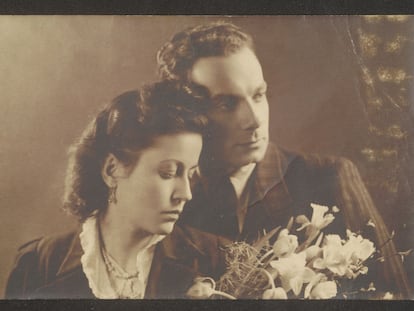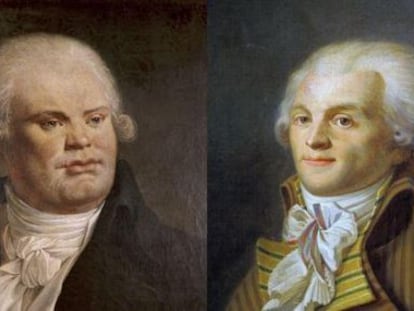‘I can’t wait to have you’: A historian discovers one hundred love letters sent to 18th-century French sailors
Over a hundred missives written by lovers, wives and mothers in 1757 offer insights into wartime communication and women’s roles during that period

“I could spend the night writing to you... I am your ever-faithful wife. Good night, my dear friend. It is the middle of the night. I think it’s time to rest.” Marie Dubosc wrote these loving words to Louis Chambrelan, the first lieutenant on the French ship Galatée in 1758, during the Seven Years’ War. He never read them. His ship was captured by the English, and the letters were seized by the British Royal Navy. Marie died the following year in Le Havre, Normandy. Louis was released, remarried and returned to France. “I can’t wait to have you,” Anne Le Cerf wrote to her husband Jean Topsent, a petty officer on the Galatée. She signed the missive as “your obedient wife Nanette,” an affectionate, almost piquant nickname. But Topsent was imprisoned in England and would never receive this passionate confession.
Instead, Renaud Morieux, a professor of history at Cambridge University, read them 263 years later. “It was very exciting,” he says in a video call. “There’s something voyeuristic about it, but it’s also tragic. These lines were never read by the people they were intended for.” The letters were taken to the Admiralty in London, where they gathered dust for over two centuries, until they were moved to the National Archives at Kew. Morieux was working on a paper on French prisoners in England, and in his archival research, he came across the letters. “There were three bundles bound together by a ribbon. The letters were very small and sealed, so I asked the archivist if I could open them,” he explains. He could and did open them.
Morieux spent months studying and deciphering 104 letters sent to French sailors on the Galatée and just published his findings in the journal Annales Histoire Sciences Sociales. The term “deciphering” is not an exaggeration, the historian explains. In the 18th century, sending a letter was expensive and communication was not very fluid, so senders would write letters in a tightly spaced scrawl, filling every inch of the expensive paper. In addition, the letters were penned by common people, who did not follow the rules of spelling but wrote the words phonetically. In order to understand them, the historian had to read aloud the words of love, family secrets and village gossip.
To reconstruct the history, Morieux also consulted church records from Normandy, the origin of most of the ship’s crew. Those archives held marriage, death and birth records. The historian also conducted research on genealogy websites and reviewed the ship’s register of sailors, until he identified about twenty of the 200 enlisted sailors.

Women wrote nearly 60% of these letters, which is remarkable given that at the time most documents were written by men. “That means that women were agents in history, not just passive subjects,” Morieux observes, “and they are seen as people with a lot of room to maneuver in the economic, political and family spheres. Thus, for example, these women pressured governments to obtain the release of their husbands and sons. They wrote to the authorities. They lined up in front of the French Navy offices, saying: ‘We still haven’t received news about our husbands.’”
The messages give an intimate glimpse into the loves, lives and family feuds in French society as a whole, from elderly peasants to wealthy officers’ wives. There were love letters like Marie’s and risqué ones like Nanette’s. And there were others who wrote missives in which they said they had had enough of such romanticism.
For instance, Marguerite, 61, wrote her son, the young sailor Nicolas Quesnel, in a text full of envy, reproach and emotional blackmail. “On the first day of the year you have written to your fiancée,” it began. “I think more of you than you do of me [...] In any case I wish you a happy new year, full of the Lord’s blessings. I think I am on my way to the grave, I have been ill for three weeks. Congratulate Varin [a shipmate], only his wife gives me news of you.” A few weeks later, Nicolas’s fiancée, a woman named Marianne, wrote him, asking that he send a letter to his mother at once; she was healthy but very difficult, which put the younger woman in an awkward situation. Nicolas Quesnel survived his imprisonment in England and, Morieux discovered, joined the crew of a transatlantic slave-trading ship in the 1760s.

“These letters are about universal human experiences; they’re not exclusive to France or the 18th century,” the professor says. History — in the singular and with a capital letter — is made up of hundreds of multiple small and human stories. Sometimes the two intermingle. “The letters include family news [and] very intimate things but also connections with great history. One letter mentions that Spain has declared war on England, and talks about possible inflation, about the price of food.” At that time, the expert points out, newspapers did not circulate much, and letters also served as a means of communicating the news.
Perhaps for this reason, Morieux highlights the combination of the private and the public in the letters he found. There could be passionate phrases (there are a couple of risqué letters), but many times someone else actually wrote the missive because the person sending it was illiterate. Or letters were mixed with greetings to their mother or neighbor. “You wonder why they didn’t censor themselves at some point, but frequently they knew that it was the last chance they had to talk to their loved ones,” the historian explains. In this regard, Morieux points out that these epistolary relationships were not bidirectional but almost social and shared in nature. It is as if the letters were a Facebook wall: a place to talk about politics, declare eternal love and send memories to cousins.
The three files Professor Morieux analyzed are exceptional in their human value but far from unique. The British Navy did not just confiscate the Galatée’s letters; it did the same with 35,000 other ships. Piles of envelopes remained forgotten for centuries in British government offices, a sort of warehouse of dead letters. These missives are known as the Prize Papers, and efforts to catalogue and digitize them began only recently. They reveal a mosaic of private lives with their own grandeur and miseries. Archivists from the British National Archives and a research team from Carl von Ossietzky University in Germany are working on a joint project, which is expected to take two decades. The idea is to open and release the histories from over 160,000 letters by making them freely accessible and easily searchable online. “There are many more unopened letters, many stories that are still waiting for someone to read them,” Morieux says.
Sign up for our weekly newsletter to get more English-language news coverage from EL PAÍS USA Edition
Tu suscripción se está usando en otro dispositivo
¿Quieres añadir otro usuario a tu suscripción?
Si continúas leyendo en este dispositivo, no se podrá leer en el otro.
FlechaTu suscripción se está usando en otro dispositivo y solo puedes acceder a EL PAÍS desde un dispositivo a la vez.
Si quieres compartir tu cuenta, cambia tu suscripción a la modalidad Premium, así podrás añadir otro usuario. Cada uno accederá con su propia cuenta de email, lo que os permitirá personalizar vuestra experiencia en EL PAÍS.
¿Tienes una suscripción de empresa? Accede aquí para contratar más cuentas.
En el caso de no saber quién está usando tu cuenta, te recomendamos cambiar tu contraseña aquí.
Si decides continuar compartiendo tu cuenta, este mensaje se mostrará en tu dispositivo y en el de la otra persona que está usando tu cuenta de forma indefinida, afectando a tu experiencia de lectura. Puedes consultar aquí los términos y condiciones de la suscripción digital.
More information
Últimas noticias
Most viewed
- Sinaloa Cartel war is taking its toll on Los Chapitos
- Reinhard Genzel, Nobel laureate in physics: ‘One-minute videos will never give you the truth’
- Oona Chaplin: ‘I told James Cameron that I was living in a treehouse and starting a permaculture project with a friend’
- Why the price of coffee has skyrocketed: from Brazilian plantations to specialty coffee houses
- David King, chemist: ‘There are scientists studying how to cool the planet; nobody should stop these experiments from happening’











































